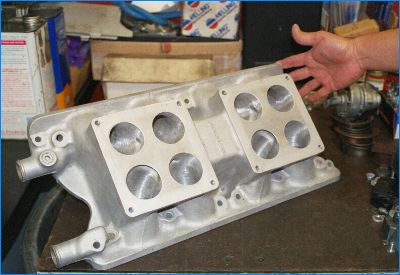
Bud Moore himself setting up a carb in a Cougar on 21.Sept. 1967.
Picture courtesy Ford Media.
The truth about Bud Moores engine building
secrets
- Part 2
O.k., maybe the picture on the left shows Bud Moore's "good old way"
of fuel vapor and ignition testing back in 1967, maybe not.
But this definitely changed for the T/A program in '69/'70 with
Fords no-limit-race support.
Still those were the Glory days, where people made the winner's
engines!
Enjoy reading - Wolfgang
How many engines were left over after 1970 Riverside and how many were sold?
After Riverside 1970, we had about 5 to 10 engines assembled plus parts.
Were Bud Moore prepped engines sold to private parties and if yes, to whom?
We put together one car we got from Shelby for a racer named Warren Tope for the 1970 SCCA runoffs at Road Atlanta. That's all I know.
Except for the first car, you got the engines in pieces from Ford. Is that true and how did they arrive? How was the quality of the parts?
The engines were indeed shipped to us in parts. We would go up to Holman and Moody to get some parts and supplies. The quality of parts was first rate. Ford paid a lot of money for them.
Which kind of modifications or processes did you do perform on parts like connecting rods, pistons, sleeves, oil rings, gaskets, valves, ports, manifold, cam, chain, distributor, exhausts etc.?
The lifter bores were cut from the underside to fit the mushroom lifters we were using. The pistons had a "fire slot" cut through where the spark plug slot was forged. We ground the ends just to keep the balance even. We balanced the crank and then the flywheel and balancer. Heads came ported and polished from Air Flow Research. I polished the intake manifolds for the 2x4 setup. This is how you will know if you have a genuine Bud Moore 2x4 Boss 302 manifold. The carburetors were blueprinted from Holley.

Edd was reunited with his #16 car dual quad manifold upon a tour through Vic Edelbrocks workshop in 2003.
Which camshafts did you try out? I read that .600 lift cams were used.
We didn't really do any camshaft testing. I do not have the specs on them but one of the engineers said that the lift was about .610.
Did you make tests with chain alternatives. Maybe gear drives?
We just used the double roller chain. We weren't allowed to use gear drives.
Did you ever do testing with other accessories (probably not superhcargers, compressors) etc just for R&D purposes?
No, we did not do any R & D other than for the program. It was very controlled.
The T/A engines are said to have been dynoed at 460-480HP. Is this the A-curve (with dyno headers) B-curve (no accessories) or C-Curve (as installed in the car)? Do you remember the values of each of these ratings.
The 460-480 HP ratings were on the dyno w/dyno headers and w/race exhaust system.
What problems appeared or had to be considered in the range of 7,000 to 9,000 rpm or above? And where did you set the limit for the drivers or team?
Because our engines were of the road race, type we would only be at those ranges for a short period of time. Falconer-Dunn did a strobe light study of the valve train at 9,000 RPM on a spintron and the rocker arm studs looked like bubble gum. To go that high you will need to go to lighter valve train parts.
We tried to have them (the drivers) keep it under 8000 RPM. George drove F5000 for Falconer-Dunn and he would turn 9000 RPM, then jump over into a 3200 pound Mustang and do the same thing! We had to slow him down on that.
Which ignition setup did you use (coil, wires, plugs, distributor cap, etc) and can you let us know any racers expertise for similar race engines
This is meant to be for vintage Mustang racers, but of course any tip for the average Joe would be appreciated as well.
We used Ford's transistorized ignition system with Ford parts. We used Autolite wires that Ford made for us. Jack Roush would be your best bet. He was a Ford drag racer at that time and would have better information than I have. Personally, I think the MSD ignition system is probably one of the best systems around for durability and power.
Can you explain a bit about the mini plenum as a change became necessary due to the new rule changes for the'70 season and perhaps something about the development of the plenum including the carburetor selection?
I can only speak from my perspective about the mini plenum. I think that the rules stated that the engines had to use a four barrel carburetor and any manifold. Ford went with a large and a mini plenum. The large plenum had a large inline 4 barrel carburetor (it was like 2 Webber carbs welded together). We tested it at Martinsville. The engine wouldn't idle unless the float level was very high. The engine would stumble out of the turns; it was awful. The mini plenum was a smaller version and used a Holly carburetor which made for a better running engine. There was a collective sigh of relief when SCCA denied the use of the inline carburetor.
Lets take another breath. Short double-clutching, shifter ratcheting and here you go....
Part 3 of more insider information now up. Wolfgang